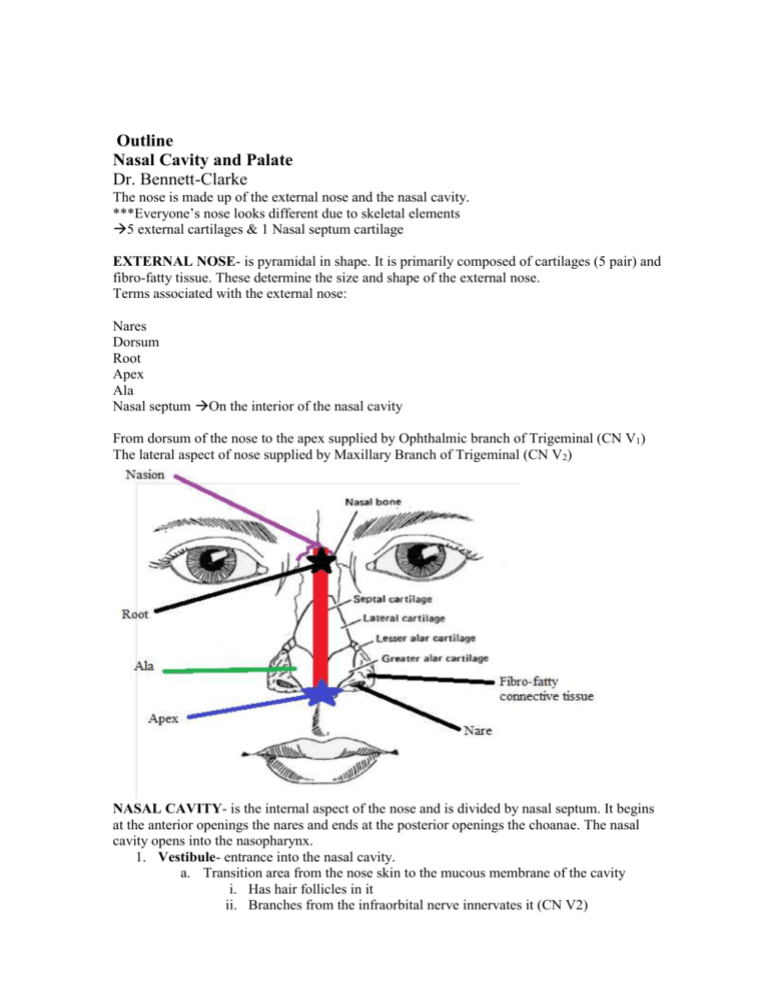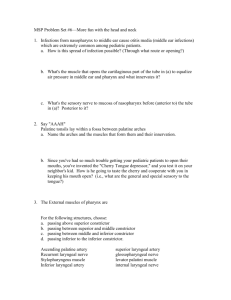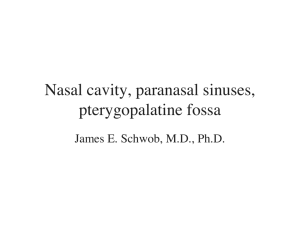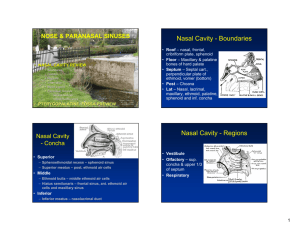Nasal Cavity, Palate, & Ptergopalatine Fossae
advertisement

Outline Nasal Cavity and Palate Dr. Bennett-Clarke The nose is made up of the external nose and the nasal cavity. ***Everyone’s nose looks different due to skeletal elements 5 external cartilages & 1 Nasal septum cartilage EXTERNAL NOSE- is pyramidal in shape. It is primarily composed of cartilages (5 pair) and fibro-fatty tissue. These determine the size and shape of the external nose. Terms associated with the external nose: Nares Dorsum Root Apex Ala Nasal septum On the interior of the nasal cavity From dorsum of the nose to the apex supplied by Ophthalmic branch of Trigeminal (CN V1) The lateral aspect of nose supplied by Maxillary Branch of Trigeminal (CN V2) NASAL CAVITY- is the internal aspect of the nose and is divided by nasal septum. It begins at the anterior openings the nares and ends at the posterior openings the choanae. The nasal cavity opens into the nasopharynx. 1. Vestibule- entrance into the nasal cavity. a. Transition area from the nose skin to the mucous membrane of the cavity i. Has hair follicles in it ii. Branches from the infraorbital nerve innervates it (CN V2) ****Mucous membrane of the nasal cavityMucous membrane & Periosteum in close contact Highly Vascular Majority of it is respiratory epithelium (Ciliated with lots mucous glands) Functions = humidify & warm the entering air (By blood vessel plexus & mucous there) 2. Nasal septum- composed of bone and cartilage. All between mucoperiosteum Bony portion: Upper : Perpendicular plate of the ethmoid bone = forms the upper part of the ethmoid Lower: Vomer = one bone & only on nasal septum Cartilage portion: (Naso)-Septal cartilage : Innervation to the nasal septum: 1) Olfactory – CN I = in olfactory mucous membrane in nasal cavity mucous membrane Olfactory Epithelium (Most superior & lateral part of the nasal septum) Bipolar neurons Peripheral processes = with chemoreceptors Sense odorants that are dissolved in the mucous And branches of trigeminal nerve 2) Respiratory – CN V1 & V2 Branches of the Trigeminal 1. Anterior Ethmoidal Nerve (CN V1) 2. Nasopalatine Nerve Blood supply to nasal septum Branches of ophthalmic a. 1. Anterior Ethmoidal Artery 2. Posterior Ethmoidal Artery Branches of maxillary a. 1. Sphenopalatine Artery 3. Lateral nasal wall- has a very irregular contour. Three curved shelves of bone extend from the lateral nasal wall, these are known as the conchae. They are curve shaped. Inferior nasal concha: 2 of them = own independent bone Middle nasal concha: Part of the Ethmoid bone Superior nasal concha: Part of the Ethmoid bone There is a passageway that lies deep to each concha; they are called the nasal meatuses. In each of these spaces there are distinctive markings and openings. Under the inferior nasal concha is the inferior meatus Passage way deep to or inferior to inferior nasal concha Under the middle nasal concha is the middle meatus Passage way deep to or inferior to Middle nasal concha Under the superior nasal concha is the superior meatus Passage way deep to or inferior to superior nasal concha Above the superior nasal concha is the sphenoethmoidal recess Nasolacrimal duct Tears will flow into the inferior nasal meatus through here Causes our nose to run when we cry Ethmoidal Bulla is a bulging bone = ethmoidal cells bulging into the cavity Opening of the Maxillary Sinus = floor of hiatus semilunaris Frontonasal duct = from frontal sinus Spenoidal Sinus = opens into sphenoethmoidal recess Innervation of the lateral nasal wall (Similar to the Nasal Suptum) Olfactory nerve Branches of trigeminal nerve 1. Anterior Ethmoidal from ophthalmic (CN V1) 2. Infraorbital nerve from maxillary (CN V2) 3. Posterior lateral nasal branches of the maxillary nerve (CN V2) Blood supply to the lateral nasal wall Vascular plexus has a look of erectile tissue Branches of ophthalmic a. 1. Anterior ethmoid artery 2. Posterior Ethmoid artery Branches of maxillary a. 1. Lateral Branches of Sphenopalatine 2. Greater palatine artery first supplies hard palate & then go through incisive foramen and up into nasal cavity to anastomose PARANASAL SINUSES- these are considered diverticula (out pockets) of the nasal cavity. There are four pair: Function 1. Lighten Skull 2. Change Resonance of voice **At birth are very small **With age = increase in size 1. Frontal Use Frontonasal duct Opens into middle meatus Opens on hiatus semilunaris 2. Maxillary Largest & in maxilla Open into middle meatus Opens on floor of hiatus semilunaris 3. Sphenoid In the body of the sphenoid bone Just deep to pituitary fossa Open into sphenoethmoidal recess (superior to Superior Ethmoidal Concha) 4. Ethmoid Sometimes called the ethmoidal air cells 8-10 on each side Grouped by position (Anterior, Middle, Posterior) Anterior – opens on hiatus semilunaris Middle – opens on surface of ethmoidal bulla Posterior – opens into superior nasal meatus Only the frontal sinus drains easily by gravity. Maxillary sinus has to go up to get into nasal cavity. Innervation: Branches of the trigeminal Example = anterior ethmoidal Nerve Innervates anterior & Middle Clinical Implications: When the mucous membranes inflame they block off the openings to the ducts that allow drainage With age = Maxillary sinus can impinge on maxillary molars Abscess of one of the molars has access to the maxillary sinus PALATE–is the structure, which separates the nasal cavity from the oral cavity. The palate consists of a bony portion the HARD PALATE and the muscular portion the SOFT PALATE. Both are covered by Oral Mucous Membrane or Mucoperiosteum. Have fold or ridges = Rugae Under the mucous membrane are Palatine glands 1. Hard palate Bones: Features: 2. Soft palate-attaches anteriorly to the hard palate and blends laterally with the pharynx. There is a core of dense connective tissue in it = Palatine Aponeurosis - Involved in attachment of muscles of soft palate Help elevate the soft palate to close the Nasopharynx Help depress soft palate (especially during initial mastication) = keep oropharynx closed Muscles of the soft palate 1. Levator veli palatini Origin: Auditory Tube Insertion: Palatine aponeurosis Action: Elevate soft palate Innervation: CN X 2.Tensor veli palatini Origin: Auditory tube Insertion: palatine aponeurosis Tendon travels around the hamulus of the medial pterygoid plate Action: Elevate the soft palate & Tenses the aponeurosis Innervation: CN V3 3.Musculus uvulae Origin: a boney spine on the hard palate Insertion: Blends with other muscles of soft palate & Insert of palatine aponeurosis Action: Final closure of the nasopharynx Innervation: CN X 4.Palatoglossus Origin: Palatine Aponeurosis Insertion: lateral aspect of tongue Action: Depress soft palate Innervation: CN X 5.Palatopharyngeus Origin: Palatine Aponeurosis Insertion: Blend with muscles of pharyngeal wall Action: Depress the soft palate & Hold elevate/open the pharynx Innervation: CN X Innervation to the palate Branches of the maxillary nerve 1. Greater palatine Runs in the Palatine Canal (Originates in the Ptergopalatine Fossa) Exits canal & travels anteriorly to hard palate - Supplies mucous membrane of hard palate 2. Lesser palatine Runs in the Palatine Canal (Originates in the Ptergopalatine Fossa) Exits canal & Travels posteriorly to the soft palate - Supplies mucous membrane of soft palate Blood supply to the palate Branches of the maxillary artery Descending Palatine Artery enters Pterygopalatine canal and divides into 2 arteries: 1. Greater palatine Exits canal & travels anteriorly to hard palate - Supplies mucous membrane of hard palate 2. Lesser palatine Exits canal & Travels posteriorly to the soft palate - Supplies mucous membrane of soft palate Incisive foramen Greater Palatine artery goes through to nasal septum Nasopalatine nerve goes through to supply anterior hard palate Pterygopalatine fossa Dr. Bennett-Clarke Definition: The PT fossa is a small pyramidal shape space located posterior and inferior to the apex of the orbit. It has three walls; • The anterior wall is formed by the posterior aspect of the maxilla. • The posterior wall is formed by the pterygoid process (Medial & Lateral Plates together) of the sphenoid bone. • The medial wall is formed by the vertical portion of the palatine bone. Palatine Bone = small & L-shaped o Vertical plates of the palatine bones make up the medial wall Lateral wall = open laterally to infratemporal fossa Ptergomaxially fissure = opening to the fossa Openings on the walls of the PT fossa: The PT fossa communicates with the orbit, nasopharynx, nasal and oral cavities, middle cranial fossa and the infratemporal fossa. 1. Laterally the PT fossa is directly communicates with the infratemporal fossa through the pterygomaxillary fissure. (There is no lateral wall to the fossa.) 2. On medial wall, the sphenopalatine foramen opens into the nasal cavity. 3. On the posterior wall there are three openings • Pharyngeal canal leads to the nasopharynx. (most medial) • Pterygoid canal near the center of the posterior wall • Foramen rotundum opens into the middle cranial fossa 4. On most superior aspect of the anterior wall, the inferior orbital fissure leads to the infraorbital canal on the floor of the orbit. 5. Inferiorly the PT fossa opens to the oral cavity via the greater palatine canal The contents of the PT fossa include: • The third portion of the maxillary artery and its branches, • The maxillary nerve and its branches, • The pterygopalatine ganglion and the nerve of the pterygoid canal. Maxillary artery: The third or terminal portion of the maxillary artery enters the PT fossa via the pterygomaxillary fissure and will end as the Sphenopalatine onto the nasal septum. Branches: • Posterior superior alveolar artery is the first branch of this portion of the artery. It exits the fossa via the pterygomaxillary fissure and pierces the maxilla to supply the upper teeth (Maxillary Molars). • Descending palatine artery exits through the palatine canal divides into greater and lesser palatine arteries to supply hard (Greater) and soft palate (Lesser). • Artery of the pterygoid canal enters the pterygoid canal. • Pharyngeal artery exits via the pharyngeal canal and ends in the nasopharynx. • Infraorbital artery traverses the inferior orbital fissure and then enters the infraorbital canal and supplies the face May give rise to an Anterior Superior Alveolar artery to supply maxillary gums and teeth. • Sphenopalatine artery, the terminal branch, enters the nasal cavity via the sphenopalatine foramen and supplies the mucosa of the nasal cavity ending on the nasal septum. Maxillary nerve (CN V2): The second division of the trigeminal or fifth cranial nerve is called the maxillary nerve. This division of the trigeminal nerve transmits only sensory information. The maxillary nerve exits the PT fossa through the foramen rotundum. Infraorbital – Travel in infraorbital canal and exits the infraorbital foramen to supply skin (lower eyelid, lateral nose include vestibule, cheek, upper lip) Anterior superior alveolar – To the teeth and gums Middle superior alveolar – often not there Posterior superior alveolar – To the teeth and gums Nasopalatine – supplies the nasal septum Greater palatine nerve – in the palatine canal exits the greater palatine foramen to supply the hard palate Lesser palatine nerve - in the palatine canal exits the lesser palatine foramen to supply the soft palate Pharyngeal – Small nerve that ends on the superior aspect of the nasopharynx Zygomatic – Two branches 1. Zygomaticofacial sensory for skin of respective areas 2. Zygomaticotemporal sensory of skin of respective areas Pterygopalatine ganglion: Located in the PT fossa suspended from the maxillary nerve by two roots. • Parasympathetic ganglion (location of postganglionic neurons) • Receives parasympathetic preganglionic fibers from CN VII in the greater petrosal nerve • Parasympathetic fibers in greater petrosal join sympathetic fibers from deep petrosal nerve to form the nerve of pterygoid canal The nerve of the pterygoid canal enters the posterior aspect of the PT fossa and ends in the pterygopalatine ganglion. Summary of information transmitted through the pterygopalatine fossa Sensory information from the nasopharynx, nasal and oral cavities travel in the infraorbital, nasopalatine, pharyngeal, greater and lesser palatine nerves. Afferent fibers in these nerves enter the PT fossa. Many of these nerve fibers will pass through the pterygopalatine ganglion. Since they are sensory fibers, they do not synapse in the ganglion.. Preganglionic parasympathetic fibers traveling in the nerve of the pterygoid canal enter the posterior aspect of the PT fossa and course toward the pterygopalatine ganglion. These preganglionic fibers synapse in the pterygopalatine ganglion and postganglionic parasympathetic fibers are distributed from the ganglion along the branches of the maxillary nerve. Postganglionic sympathetic fibers traveling in the nerve of the pterygoid canal enter the posterior aspect of the PT fossa and course toward the pterygopalatine ganglion. These postganglionic sympathetic fibers pass through the ganglion without synapsing are distributed from the ganglion along the branches of the maxillary nerve.






